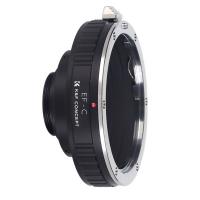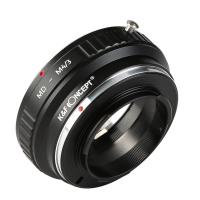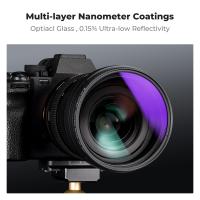How To Calculate Microscope Field Of View ?
To calculate the microscope field of view, you need to know the magnification of the microscope and the diameter of the field diaphragm. The field of view refers to the area visible through the microscope's eyepiece.
The formula to calculate the microscope field of view is:
Field of View = (Field Diaphragm Diameter) / (Magnification)
First, measure the diameter of the field diaphragm using a ruler or a calibrated eyepiece graticule. Then, determine the magnification of the microscope, which is usually indicated on the eyepiece or objective lens.
Once you have these values, divide the field diaphragm diameter by the magnification to obtain the field of view. Keep in mind that the field of view may vary depending on the microscope model and the objective lens in use.
It is important to note that this calculation assumes a circular field of view. If the field of view is not circular, you may need to measure the length and width separately and calculate the area using appropriate formulas.
1、 Determining the Microscope Magnification
To calculate the microscope field of view, you need to determine the microscope magnification first. The magnification of a microscope is the ratio of the size of the image seen through the microscope to the actual size of the object being observed. There are two types of magnification: the eyepiece magnification and the objective magnification.
To calculate the total magnification, you need to multiply the eyepiece magnification by the objective magnification. The eyepiece magnification is usually written on the eyepiece itself, while the objective magnification is written on the objective lens.
Once you have determined the magnification, you can calculate the microscope field of view. The field of view refers to the diameter of the circular area visible through the microscope. It is usually measured in millimeters or micrometers.
To calculate the field of view, you need to know the diameter of the field of view at a known magnification. This information is usually provided by the microscope manufacturer or can be measured using a stage micrometer. Once you have the diameter of the field of view at a known magnification, you can use the following formula to calculate the field of view at a different magnification:
Field of View 2 = (Magnification 1 / Magnification 2) x Field of View 1
Where Field of View 2 is the field of view at the desired magnification, Magnification 1 is the known magnification, Field of View 1 is the known field of view diameter, and Magnification 2 is the desired magnification.
It is important to note that the field of view may vary depending on the microscope and the objective lens being used. Additionally, advancements in technology have led to the development of microscopes with wider fields of view, allowing for greater observation capabilities.

2、 Calculating the Microscope Field Diameter
Calculating the microscope field of view involves determining the diameter of the area visible through the microscope's eyepiece. This measurement is crucial for various applications, such as estimating the size of microscopic objects or calculating magnification.
To calculate the microscope field diameter, you need to know the magnification of the objective lens and the diameter of the field diaphragm. The field diaphragm is a component of the microscope that controls the amount of light entering the eyepiece.
First, determine the diameter of the field diaphragm. This can usually be found in the microscope's specifications or by measuring it directly using a ruler or caliper. Let's assume the field diaphragm diameter is 1.5 millimeters.
Next, determine the magnification of the objective lens. This information is typically engraved on the lens itself or can be found in the microscope's documentation. Let's assume the objective lens has a magnification of 40x.
To calculate the microscope field diameter, use the following formula:
Field Diameter = (Field Diaphragm Diameter) / (Objective Lens Magnification)
In our example, the field diameter would be:
Field Diameter = 1.5 mm / 40x = 0.0375 mm or 37.5 micrometers
It's important to note that the field of view can vary depending on the microscope model and the specific objective lens being used. Additionally, advancements in technology have led to the development of microscopes with wider fields of view, allowing for greater visibility and analysis of microscopic samples.
In conclusion, calculating the microscope field of view involves determining the diameter of the field diaphragm and dividing it by the magnification of the objective lens. This calculation provides an estimate of the diameter of the area visible through the microscope's eyepiece and is essential for various microscopic applications.

3、 Estimating the Microscope Field of View
To calculate the microscope field of view, you need to know the magnification power of the objective lens and the diameter of the field diaphragm. The field of view refers to the area visible through the microscope when looking into the eyepiece.
First, determine the magnification power of the objective lens. This information is usually printed on the lens itself or can be found in the microscope's specifications. The magnification power is typically written as a number followed by an "x" (e.g., 10x, 40x, 100x).
Next, locate the field diaphragm, which is usually a circular opening located near the base of the microscope. Measure the diameter of the field diaphragm using a ruler or a calibrated eyepiece micrometer.
To calculate the field of view, use the following formula:
Field of View = (Diameter of Field Diaphragm) / (Magnification Power)
For example, if the diameter of the field diaphragm is 2 millimeters and the magnification power is 40x, the field of view would be:
Field of View = 2 mm / 40x = 0.05 mm
It's important to note that the field of view is typically measured in millimeters or micrometers. Additionally, the actual field of view may vary depending on the specific microscope and its optical system.
It's worth mentioning that some modern microscopes have built-in digital cameras or eyepiece adapters that allow for direct measurement of the field of view using software or calibration tools. These methods can provide more accurate and precise measurements.
In conclusion, calculating the microscope field of view involves determining the magnification power of the objective lens and measuring the diameter of the field diaphragm. By using the formula provided, you can estimate the field of view and understand the area visible through the microscope.

4、 Considering the Objective Lens and Eyepiece Specifications
To calculate the microscope field of view, you need to consider the specifications of both the objective lens and the eyepiece. The field of view refers to the diameter of the area visible through the microscope at a given magnification. It is an important parameter as it determines the amount of the specimen that can be observed at once.
First, you need to determine the magnification of the objective lens. This information is usually provided on the lens itself or in the microscope's documentation. Next, you need to determine the magnification of the eyepiece. Again, this information can be found on the eyepiece or in the microscope's documentation.
Once you have the magnification values, you can calculate the total magnification by multiplying the magnification of the objective lens by the magnification of the eyepiece. For example, if the objective lens has a magnification of 40x and the eyepiece has a magnification of 10x, the total magnification would be 400x.
To calculate the field of view, you need to know the diameter of the field of view at a specific magnification. This information is usually provided by the manufacturer or can be measured using a stage micrometer. Once you have the diameter of the field of view, you can divide it by the total magnification to calculate the field of view at that specific magnification.
It is important to note that the field of view can vary depending on the microscope model and the quality of the lenses. Additionally, advancements in technology have led to the development of microscopes with wider fields of view, allowing for a larger area of the specimen to be observed simultaneously. Therefore, it is always recommended to consult the microscope's documentation or contact the manufacturer for the most accurate and up-to-date information on calculating the field of view.
































There are no comments for this blog.